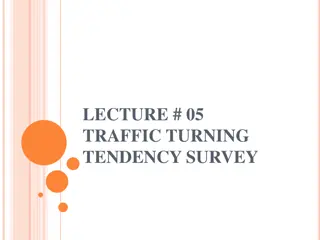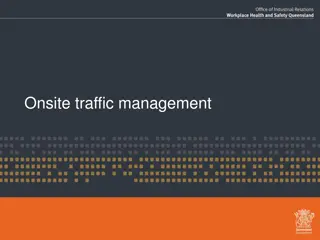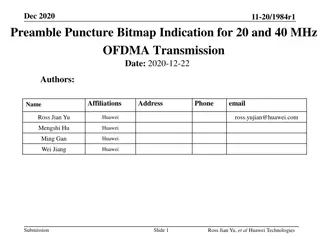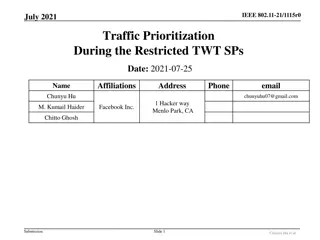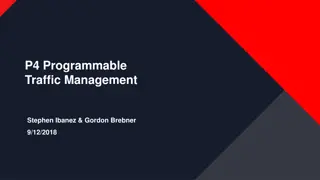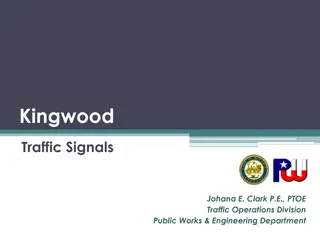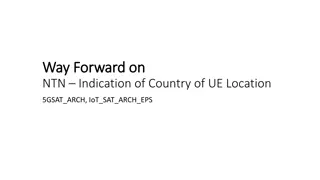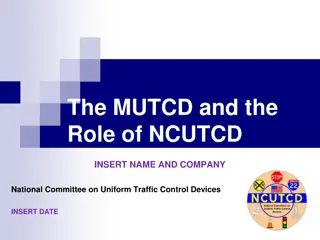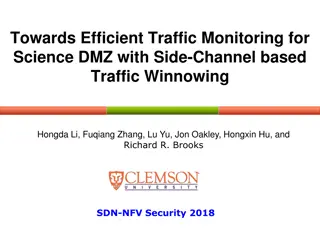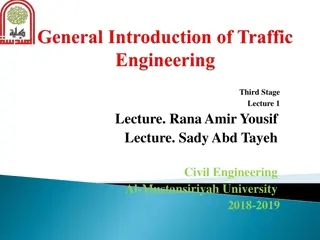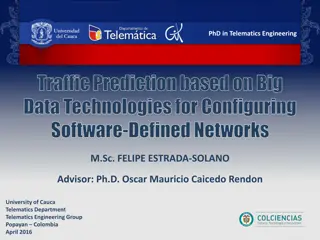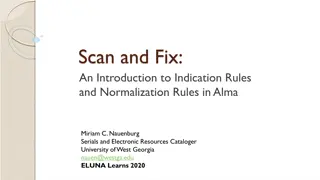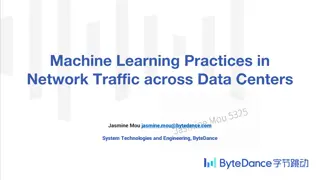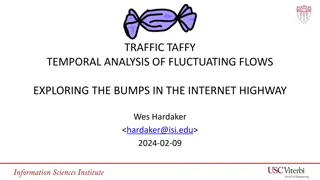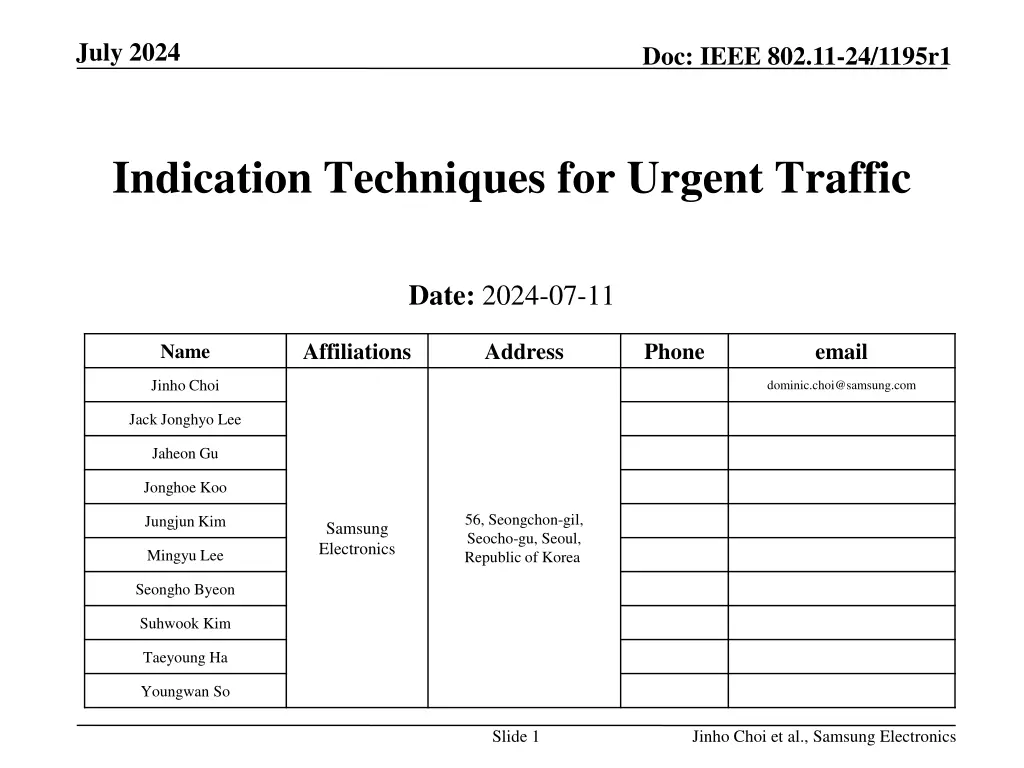
Efficient Techniques for Identifying Urgent Traffic in IEEE 802.11 Networks
Explore strategies for effectively detecting and managing urgent traffic in IEEE 802.11 networks to enhance latency distribution and support low latency transmissions. Discover how to prioritize aperiodic low latency traffic and improve resource allocation for timely data delivery.
Download Presentation

Please find below an Image/Link to download the presentation.
The content on the website is provided AS IS for your information and personal use only. It may not be sold, licensed, or shared on other websites without obtaining consent from the author. If you encounter any issues during the download, it is possible that the publisher has removed the file from their server.
You are allowed to download the files provided on this website for personal or commercial use, subject to the condition that they are used lawfully. All files are the property of their respective owners.
The content on the website is provided AS IS for your information and personal use only. It may not be sold, licensed, or shared on other websites without obtaining consent from the author.
E N D
Presentation Transcript
July 2024 Doc: IEEE 802.11-24/1195r1 Indication Techniques for Urgent Traffic Date: 2024-07-11 Affiliations Address Phone email Name Jinho Choi dominic.choi@samsung.com Jack Jonghyo Lee Jaheon Gu Jonghoe Koo 56, Seongchon-gil, Seocho-gu, Seoul, Republic of Korea Jungjun Kim Samsung Electronics Mingyu Lee Seongho Byeon Suhwook Kim Taeyoung Ha Youngwan So Slide 1 Jinho Choi et al., Samsung Electronics
July 2024 Doc: IEEE 802.11-24/1195r1 Introduction In order to improve tail of the latency distribution and jitter, which is one of the objectives of 802.11bn [1], it has been actively discussed how to support aperiodic low latency (LL) traffic, mainly including preemption [2-5] In order to support timely transmission of LL traffic with stringent latency requirement, it is important to efficiently identify its presence because it needs to be frequently checked In this submission, we discuss how to effectively identify urgent traffic in consideration of the relative importance of traffic Slide 2 Jinho Choi et al., Samsung Electronics
July 2024 Doc: IEEE 802.11-24/1195r1 Overview of UL LL Traffic Support 1. TXOP holder checks the existence of LL traffic and may also collect additional information such as buffer status The soliciting frame may be delivered explicitly (e.g., BSRP or NFRP) or implicitly (e.g., included in a data frame) LL STAs notify the presence of LL traffic and may provide solicited additional information LL traffic is transmitted using the resources allocated according to the exchanged information as described above Slide 3 2. 3. Jinho Choi et al., Samsung Electronics
July 2024 Doc: IEEE 802.11-24/1195r1 A Scenario to Consider Since all STAs can access RA-RUs as per current spec., multiple LL STAs (even non-LL STAs) may select the same RA-RU to send their BSRs Due to the collision, transmission of more urgent traffic may fail due to the transmission attempt of traffic that can afford delay Similar problem always exist in any cases where randomness exists Slide 4 Jinho Choi et al., Samsung Electronics
July 2024 Doc: IEEE 802.11-24/1195r1 Thoughts on Traffic/STA Identification An efficient use of resources to identify urgent traffic is essential Since TXOP holder doesn t know who has LL traffic, the use of RA-RU(s) can be helpful to efficiently discover the presence Due to the nature of LL traffic, its presence needs to be identified by a concise procedure repeated at short intervals An effective method to identify the relative importance of traffic is also required It is desirable that the importance of traffic is determined according to the situation at the time of transmission (e.g., more likely to violate its QoS requirements) At a given opportunity, for example, more urgent traffic should be sent in a timely manner to meet their requirements so as not to degrade user experience Therefore, identifying eligible STA(s) in an efficient and effective way is an important design criterion An eligible STA in this context is regarded as a STA having traffic satisfying certain specified condition(s) (e.g., remaining delay budget, traffic category) Slide 5 Jinho Choi et al., Samsung Electronics
July 2024 Doc: IEEE 802.11-24/1195r1 Proposal Enabling TXOP holder (or AP) to specify condition(s) for resources used for sending traffic information To effectively consider the priority of traffic while filtering out ineligible traffic Ex) Condition 1 (C1): remaining delay is less than 3ms, Condition 2 (C2): remaining delay is not less than 3ms but less than 10ms STA(s) shall transmit the response according to the conditions Any STA with traffic that satisfies the condition can send a response Slide 6 Jinho Choi et al., Samsung Electronics
July 2024 Doc: IEEE 802.11-24/1195r1 Setting and Utilizing Conditions The conditions may be set based on various criteria as needed Ex) residual delay, buffered data size, AC, TID, AID, etc., and their combination TXOP holder can differentiate the competition rate (priority) by allocating different amounts of resources for each condition Ex) X RA-RUs for condition 1 & Y RA-RUs for condition 2, where X Y TXOP holder can adjust the conditions and resources depending on the BSS environment (number of STAs, number of streams, etc.) TXOP holder may manage the conditions dynamically by including them in some frames, or may manage them (semi-)statically by announcing via beacon or the like Although the possibility of collision is not completely eliminated, it seems to be a more scalable approach TXOP holder doesn t need to manage additional context for LL STA or LL stream Slide 7 Jinho Choi et al., Samsung Electronics
July 2024 Doc: IEEE 802.11-24/1195r1 Application of the Proposal The proposed scheme is applicable to various procedures to support LL traffic, including preemption mechanisms that have been discussed If the probability of collision can be reduced enough by further specifying the conditions, it can also be considered to skip the STA identification step and transmit LL traffic immediately by using Basic TF with UORA In the EDCA-based preemption mechanism [2], the conditions can be used to apply different contention parameters or to control the traffic to participate in the contention When the Zadoff-Chu sequence is used as a PR signal [6], it can be used to adjust competition rate by allowing STAs to select an index in different ranges depending on the conditions Slide 8 Jinho Choi et al., Samsung Electronics
July 2024 Doc: IEEE 802.11-24/1195r1 Conclusion In order to support LL traffic well, it is important to identify LL STA(s) efficiently and effectively In this contribution, we discussed how to indicate the eligibility to use resources to inform the presence of urgent traffic, which consequently differentiates transmission opportunities according to the relative importance of traffic The proposed scheme is applicable to various procedures to support LL traffic Slide 9 Jinho Choi et al., Samsung Electronics
July 2024 Doc: IEEE 802.11-24/1195r1 References [1] 23/0480r3, UHR proposed PAR [2] 23/1886r3, Preemption techniques to meet low-latency (LL) targets [3] 24/0131r0, Signaling of preemption [4] 24/0168r0, TXOP preemption in 11bn [5] 24/0390r0, A uniform procedure for preemption [6] 24/0431r2, Signal for preemption request Slide 10 Jinho Choi et al., Samsung Electronics
July 2024 Doc: IEEE 802.11-24/1195r1 SP #1 Do you agree to define a mechanism in 11bn for a TXOP holder to allow a STA to indicate the presence of traffic for low latency traffic delivery within its TXOP? Note: TXOP holder can be an AP or a non-AP STA Note: Policy for TXOP holder allowing indication is TBD Slide 11 Jinho Choi et al., Samsung Electronics
July 2024 Doc: IEEE 802.11-24/1195r1 SP #2 Do you agree to define a mechanism for an AP to restrict STA(s) to conditionally[Note] indicate the presence of traffic for urgent traffic delivery? Note: Conditions are TBD (e.g., remaining delay, TID, etc.) Slide 12 Jinho Choi et al., Samsung Electronics

